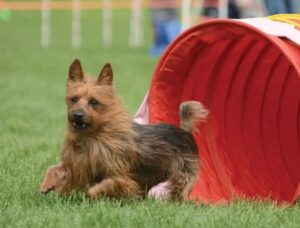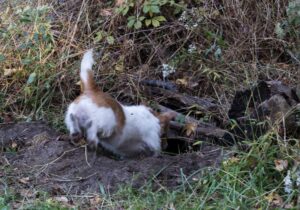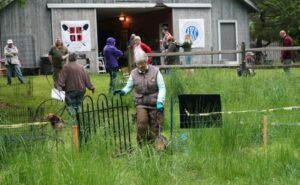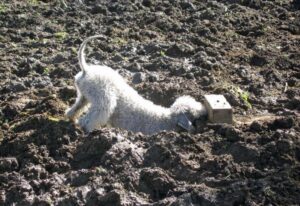
The Australian Terrier Performance
Explore the various Performance events you can participate in with your fast, agile, fearless, and self-confident Australian Terrier dogs.
Home » Dog Sports » Earthdog Dog Sport
The sport of Earthdog uniquely and dynamically showcases the inherent instincts and abilities of small terriers and Dachshunds. This activity taps into the ancestral roots of these breeds, which were historically bred for hunting vermin and small game in underground dens. In Earthdog Trials, these innate behaviors are showcased and honed in a safe, controlled environment, offering a fascinating glimpse into the natural world of these spirited dogs.
The appeal of Earthdog lies not only in its competitive aspect but also in its ability to strengthen the bond between dogs and their owners. It provides a structured outlet for the dogs’ natural inclinations to dig, scent, and pursue, turning what might be problematic behaviors in a home setting into a positive and rewarding experience. For owners, Earthdog Trials offer a unique opportunity to understand and appreciate the historical and inherent characteristics of their canine companions.
The origins of Earthdog can be traced back to the practical needs of rural living, where small terriers and Dachshunds played a crucial role in controlling populations of vermin and small game. These dogs were prized for their tenacity, courage, and instinctual ability to hunt and navigate underground burrows. Initially, these skills were utilized in day-to-day farm activities, helping to manage pests like rats, rabbits, and foxes, which often took refuge in underground dens.
Over time, as the need for such practical hunting declined due to changes in agriculture and lifestyle, enthusiasts of these breeds sought to preserve and celebrate their unique skills. This led to the conceptualization of Earthdog Trials as we know them today—a sport that replicates the historical hunting tasks of these breeds in a competitive and humane format.
The transformation of these natural hunting practices into a structured sport began in earnest in the late 20th century. Clubs and organizations dedicated to terriers (and related breeds) and Dachshunds started organizing formal events to test and showcase the hunting abilities of these dogs in a controlled environment. The key was to create a situation that was safe for both the dogs and the quarry (typically rats), ensuring no harm came to any animals involved.
These events gradually evolved into the Earthdog Trials, with standardized rules and levels of difficulty. The American Kennel Club (AKC) and similar organizations worldwide began to formalize and regulate these trials, introducing various titles and certifications that dogs could earn. This recognition helped to promote Earthdog as a legitimate and respected canine sport.
Today, Earthdog Trials are celebrated events within the dog sport community, attracting enthusiasts who are passionate about maintaining and celebrating the heritage of these breeds. The tests have become more sophisticated, with intricate tunnel designs and stringent rules to ensure fairness and safety. Despite these developments, the essence of Earthdog remains true to its roots—it’s a celebration of the natural instincts and abilities of small terriers and Dachshunds.
The sport’s evolution from a practical necessity to a competitive sport has played a significant role in preserving the hunting instincts of these breeds. It serves as a bridge, connecting the past and present, and allows today’s dogs to engage in activities deeply rooted in their historical purpose while providing dog owners with a unique way to bond with and understand their canine companions.
Earthdog Tests are designed to evaluate the natural instincts and abilities of small terriers and Dachshunds in a simulated underground hunting environment. These tests are structured to mimic the real-life scenarios these breeds were originally bred for, such as hunting vermin in burrows. The key elements of these tests focus on assessing the dog’s keenness, agility, and hunting skills under controlled conditions.
A central feature of Earthdog Trials is the tunnel system. These man-made tunnels are constructed to replicate the underground dens and burrows that dogs would naturally navigate while hunting. The complexity of these tunnels varies according to the level of the trialt. This typically includes a series of turns, false exits, and obstacles that test the dog’s ability to scent, navigate, and solve problems. The tunnels are designed to be safe for the dogs, with features like wooden linings to prevent collapse.
The quarry in Earthdog Tests, typically rats, plays a crucial role. The rats are securely caged to ensure their safety and the safety of the participating dogs. The objective for the dog is not to catch the quarry but to locate it within the tunnel system and then “work” it. This working is demonstrated by behaviors such as barking, scratching, or digging near the quarry. These actions reflect the dog’s hunting instinct and ability to signal to their handler that they have located their target.
Earthdog Trials demonstrate a range of behaviors that are indicative of a dog’s natural hunting instincts. These include the willingness to enter and navigate through dark, narrow spaces, the ability to scent and track the quarry, and the persistence to work the quarry once located. The dogs are judged based on their enthusiasm, efficiency, and how effectively they demonstrate these hunting behaviors.
The tests are structured into various levels, each with increasing difficulty. Beginners start with simpler tasks, such as entering a short tunnel to find the quarry, and can progress to more advanced levels where they must navigate longer tunnels with more complex layouts and distractions. This progression allows dogs to gradually build their skills and confidence in the sport.
Earthdog Trials are specifically designed for small terriers and Dachshunds, acknowledging their historic roles in hunting and vermin control. To participate in these tests, there are certain eligibility criteria that need to be met, which are primarily focused on breed, age, and registration status.
The primary breeds eligible for Earthdog Trials, chosen for their inherent traits and hunting capabilities, include:
The Dachshund is uniquely suited for Earthdog Trials due to its long body and short legs, which aid in tunneling. Originally bred for hunting underground game, the breed exhibits strong instincts and physical traits that make it an excellent participant in these trials.
These breeds are renowned for their energetic nature and for their ability to navigate underground tunnels, making them ideal for the demanding environment of Earthdog Trials.
Age is an important factor in determining eligibility for Earthdog Trials. Typically, dogs need to be at least six months old to participate. This age requirement ensures that the dogs are physically and mentally mature enough to safely navigate the tunnels and perform the tasks required in the trials.
Registration with a recognized kennel club is often a prerequisite for participation in official Earthdog events. For instance, dogs participating in AKC-sanctioned Earthdog Trials must be registered with the AKC. Some organizations also allow dogs with an “Indefinite Listing Privilege” (ILP) number, which typically applies to purebred dogs that may not have registration papers. Additionally, spayed and neutered dogs are often eligible to compete, making the sport inclusive for a wider range of dogs within the specified breeds.
Earthdog Trials offer a progression system that allows dogs to develop and showcase their skills through various levels of complexity. Starting from introductory levels designed for beginners, these trials gradually increase in difficulty, presenting more challenging tasks and scenarios as dogs and handlers gain experience and skill.
The first stage in Earthdog Trials is often the “Introduction to Quarry” (IQ) level. This level is designed to familiarize dogs with the basics of Earthdog activities. In the IQ test, dogs are introduced to a short, straight tunnel, typically around 10 feet long, with a caged quarry (rat) at the end. The goal is to encourage the dog to enter the tunnel, navigate to the quarry, and demonstrate an interest to work the quarry, such as by barking, digging, or scratching at the bars. This level is more about introducing the dog to the concept of Earthdog Trials and less about competition.
The next level, Junior Earthdog (JE), introduces more complexity. The tunnel system in the JE test is longer, usually around 30 feet, with several right-angle turns. Dogs are required to navigate the tunnel within a specific time frame, locate the quarry, and work it continuously for a set duration. Success at this level requires the dog to demonstrate not only its natural instinct but also obedience and control.
In the Senior Earthdog (SE) level, the challenges become more intricate. The SE course features a tunnel similar to the JE level but includes additional elements such as false exits and unscented bedding areas. The dog must demonstrate the ability to discriminate between these distractions and the true quarry location. The SE tests not only the dog’s hunting ability but also its problem-solving skills and focus.
Master Earthdog (ME) is the most advanced level in Earthdog Trials. This level simulates a realistic hunting scenario where dogs must hunt cooperatively in pairs (braces). The ME course is complex, with obstacles, false dens, and a variety of turns and challenges. Dogs must locate the tunnel entrance, navigate to the quarry, work it effectively, and respond to their handler’s commands. This level tests the dog’s hunting skills, teamwork, and obedience under challenging conditions.
Some organizations also offer an Endurance Earthdog (EE) title, which is awarded to dogs that successfully complete both SE and ME levels in the same event. This title is a testament to the dog’s consistency and versatility in Earthdog activities.
As Earthdog has grown in popularity and recognition, various organizations have emerged to support, regulate, and promote this unique dog sport. These organizations range from those focused exclusively on Earthdog activities to broader canine associations that include Earthdog as one of their many disciplines. These organizations play a crucial role in standardizing Earthdog Trials, establishing guidelines, and fostering the community of enthusiasts.
Training for Earthdog trials involves a combination of nurturing instinctual behaviors and teaching controlled responses. The goal is to prepare dogs not only to navigate tunnels and locate quarry but also to do so under the guidance of their handlers and within the rules of the competition.
The first step in Earthdog training is to encourage and develop the dog’s natural hunting instincts. This includes exercises to enhance scent tracking, digging, and alerting behaviors typically associated with finding and working the quarry. However, it’s not just about encouraging these natural behaviors; dogs must also learn to perform these tasks under controlled conditions, responding to commands and navigating courses within set time limits.
A key aspect of Earthdog training is familiarizing the dog with tunnel environments. Initial training might involve introducing the dog to a short, simple tunnel, and gradually increasing the tunnel’s length and complexity as the dog becomes more comfortable. This gradual approach helps to build the dog’s confidence in navigating confined spaces and working in the dark, simulating the conditions that will be encountered in actual Earthdog Trials.
Obedience training is crucial for Earthdog Trials. Dogs must learn to respond to their handler’s commands, both in and out of the tunnels. This includes starting and stopping on command, recalling from the tunnel, and staying focused amidst distractions. Effective communication between the dog and handler is essential for success in Earthdog, particularly at higher levels where the tasks become more challenging.
Practice through mock trials can be incredibly beneficial. Setting up practice courses that mimic actual Earthdog tunnels, complete with turns, false exits, and safe quarry simulation, can provide invaluable experience. Participating in these mock trials gives dogs a taste of what to expect in real competitions and allows handlers to fine-tune their training strategies.

Explore the various Performance events you can participate in with your fast, agile, fearless, and self-confident Australian Terrier dogs.

The 2022 National Earthdog Test had 130 overall entries, with a significant number of them freshly stripped and trimmed from Montgomery.

Earthdog tests provide a venue so that all dog owners can test and evaluate their dogs’ ability to do the job for which they are bred.

NATIONAL EARTHDOG TESTS hosted by the Bedlington Terrier Club of America, Monday (Columbus Day) October 10, 2022. Ev-ry Place, LLC., 1333
"*" indicates required fields
Showsight Magazine–the world’s most influential purebred dog publication since 1992. Each issue reaches a global audience dedicated to preserving the history and health of purpose bred dogs. Filled with award-winning editorial focused on news and insights from the dog show community, top breeders, handlers, AKC Judges, and more!